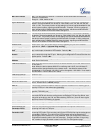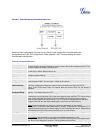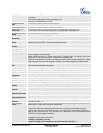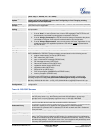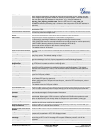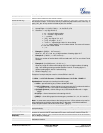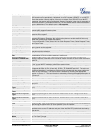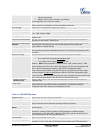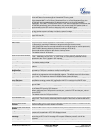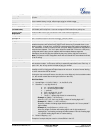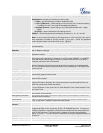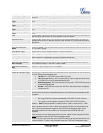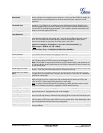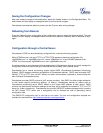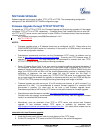
Grandstream Networks, Inc. HT503 User Manual Page 29 of 38
Firmware 1.0.4.2 Last Updated: 06/2011
• High (initial 200ms, min 40ms, max 600ms) Note: not all vocoders can meet
the high requirement
• Medium (initial 100ms, min 20ms, max 200ms)
Low (initial 50ms, min 10ms, max 100ms)
SRTP Mode
Secure RTP protocol used for media transmission over VoIP. Disabled by default.
Other modes are: enabled but not forced & enabled and forced.
SLIC Setting
Dependent on standard phone type (and location).
Called ID Scheme
Bellcore/Telcordia, ETSI-FSK, ETSI-DTMF, SIN 227 – BT, & NTT Japan
Caller ID TX Level (dB)
A value of level for Caller ID information sent by a FXS port to phone connected to it.
(-40 – 0dB. Default -20dB)
Polarity Reversal
If set to “Yes”, polarity will be reversed upon call establishment and termination.
Default is No.
Loop Current Disconnect
Set it to “Yes” of the traditional PBX you are using with HT503 uses this method for
signaling call termination. Default is No.
Loop Current Disconnect
Duration
A configurable period of time in which the FXS port will drop off voltage on the line to
indicate to the local party that the call is disconnected from the remote side.
(100-10000 ms. Default 200 ms)
Hook Flash Timing
The time period when the cradle is pressed (Hook Flash) to simulate a FLASH. Adjust
this time value to prevent unwanted activation of the Flash/Hold and automatic phone
ring-back.
On Hook Timing
On-hook timing is the minimum time for an on-hook event to be validated.
Gain
Voice path volume adjustment.
• Rx is a gain level for signals transmitted by FXS
• Tx is a gain level for signals received by FXS.
Default = 0dB for both parameters. Loudest volume: +6dB Lowest volume: -6dB.
User can adjust volume of call on either end using the Rx Gain Level parameter and
the Tx Gain Level parameter located on the FXS Port Configuration page.
If call volume is too low when using the FXS port (ie. the ATA is at user site), adjust
volume using the Rx Gain Level parameter under the FXS Port Configuration page.
If voice volume is too low at the other end, user may increase the far end volume using
the Tx Gain Level parameter under the FXS Port Configuration page.
Disable Line Echo
Canceller (LEC)
Default is No. If set to “Yes” LEC will be disabled per call base. Recommended for
FAX/Data calls.
Ring Tones
This function lets you configure ring or tone frequencies according to preference. By
default tones are set to North American frequencies. Frequencies should be
configured with known values to avoid high pitch sounds.
T
ABLE 11: FXO PORT SETTINGS
Account Active
When set to “Yes” the FXO port is activated.
SIP Serve
r
SIP Server’s IP address or Domain name provided by VoIP Service Provider.
Failover SIP Serve
r
This Field contains the URL or the IP address of a second SIP server, this one will be
used in case the device looses the connection with the first server.
Prefer Primary SIP
Server
Default is no. If set to yes it will register to Primary Server if registration with Failover
server expires
Outbound Proxy
IP address or Domain name of Outbound Proxy, or Media Gateway, or Session Border
Controller. Used by HT503 for firewall or NAT penetration in different network
environments. If symmetric NAT is detected, STUN will not work and ONLY way to
correct the problem is to use the outbound proxy.
SIP Transport
User can select UDP, TCP or TLS
NAT Traversal (STUN)
This parameter defines whether or not the HT503 NAT traversal mechanism is
activated. If set to “Yes” with a STUN server also specified, the HT503 will perform



